Geometry index
In structural chemistry and crystallography, the geometry index or structural parameter (τ) is the number in a range 0...1 that indicates what the geometry of the coordination center is. The first such parameter for 5-coordinate compounds was developed in 1984. Later, parameters for 4-coordinate compounds were developed. There is on-line application for determining geometry indices on the basis of 3D structural files.[1]
5-coordinate compounds

To distinguish whether the geometry of the coordination center is trigonal bipyramidal or square pyramidal, the τ5 (originally just τ) parameter was proposed by Addison et al.:[2]
where: β > α are the two greatest valence angles of the coordination center.
When τ5 is close to 0 the geometry is similar to square pyramidal, while if τ5 is close to 1 the geometry is similar to trigonal bipyramidal:
- Extreme values of τ5
 Square pyramidal geometry
Square pyramidal geometry
(β = α = 180°)
τ5 = 0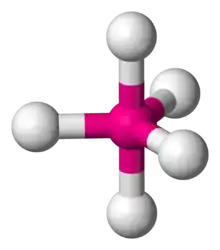 Trigonal bipyramidal geometry
Trigonal bipyramidal geometry
(β = 180°, α = 120°)
τ5 = 1
4-coordinate compounds
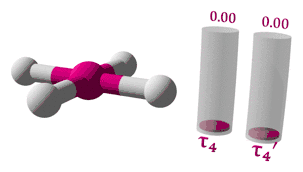
In 2007 Houser et al. developed the analogous τ4 parameter to distinguish whether the geometry of the coordination center is square planar or tetrahedral.[3] The formula is:
where: α and β are the two greatest valence angles of coordination center; θ = cos−1(− 1⁄3) ≈ 109.5° is a tetrahedral angle.
When τ4 is close to 0 the geometry is similar to square planar, while if τ4 is close to 1 then the geometry is similar to tetrahedral. However, in contrast to the τ5 parameter, this does not distinguish α and β angles, so structures of significantly different geometries can have similar τ4 values. To overcome this issue, in 2015 Okuniewski et al. developed parameter τ4′ that adopts values similar to τ4 but better differentiates the examined structures:[4]
where: β > α are the two greatest valence angles of coordination center; θ = cos−1(− 1⁄3) ≈ 109.5° is a tetrahedral angle.
Extreme values of τ4 and τ4′ denote exactly the same geometries, however τ4′ is always less or equal to τ4 so the deviation from ideal tetrahedral geometry is more visible. If for tetrahedral complex the value of τ4′ parameter is low, then one should check if there are some additional interactions within coordination sphere. For example, in complexes of mercury(II), the Hg···π interactions were found this way.[5]
- Selected geometries and corresponding values of τ4 and τ4′
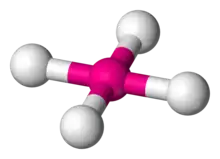 Square planar geometry
Square planar geometry
(β = α = 180°)
τ4 = τ4′ = 0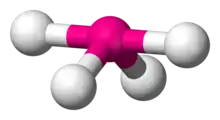 Seesaw geometry
Seesaw geometry
(β = 180°, α = 120°)
τ4 ≈ 0.43, τ4′ ≈ 0.24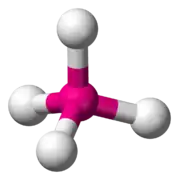 Tetrahedral geometry
Tetrahedral geometry
(β = α = θ ≈ 109.5°)
τ4 = τ4′ = 1
References
- http://kchn.pg.gda.pl/geom/
- Addison, A. W.; Rao, N. T.; Reedijk, J.; van Rijn, J.; Verschoor, G. C. (1984). "Synthesis, structure, and spectroscopic properties of copper(II) compounds containing nitrogen–sulphur donor ligands; the crystal and molecular structure of aqua[1,7-bis(N-methylbenzimidazol-2′-yl)-2,6-dithiaheptane]copper(II) perchlorate". J. Chem. Soc., Dalton Trans.: 1349. doi:10.1039/dt9840001349.
- Yang, L.; Powell, D. R.; Houser, R. P. (2007). "Structural variation in copper(I) complexes with pyridylmethylamide ligands: structural analysis with a new four-coordinate geometry index, τ4". Dalton Trans.: 955. doi:10.1039/b617136b.
- Okuniewski, A.; Rosiak, D.; Chojnacki, J.; Becker, B. (2015). "Coordination polymers and molecular structures among complexes of mercury(II) halides with selected 1-benzoylthioureas". Polyhedron. 90: 47–57. doi:10.1016/j.poly.2015.01.035.
- Rosiak, D.; Okuniewski, A.; Chojnacki, J. (2018). "Novel complexes possessing Hg‒(Cl, Br, I)···O=C halogen bonding and unusual Hg2S2(Br/I)4 kernel. The usefulness of τ4′ structural parameter". Polyhedron. 146: 35–41. doi:10.1016/j.poly.2018.02.016.